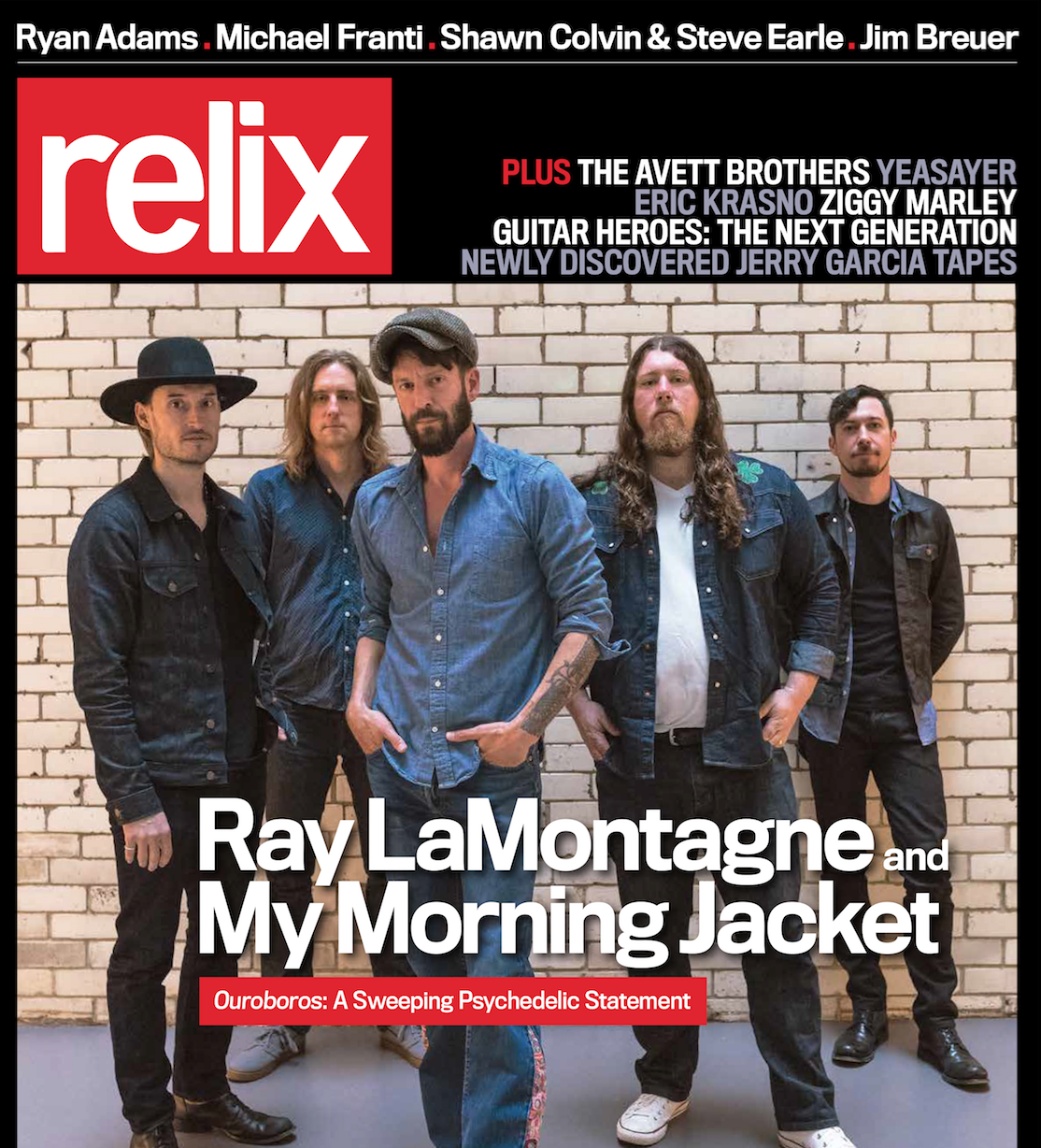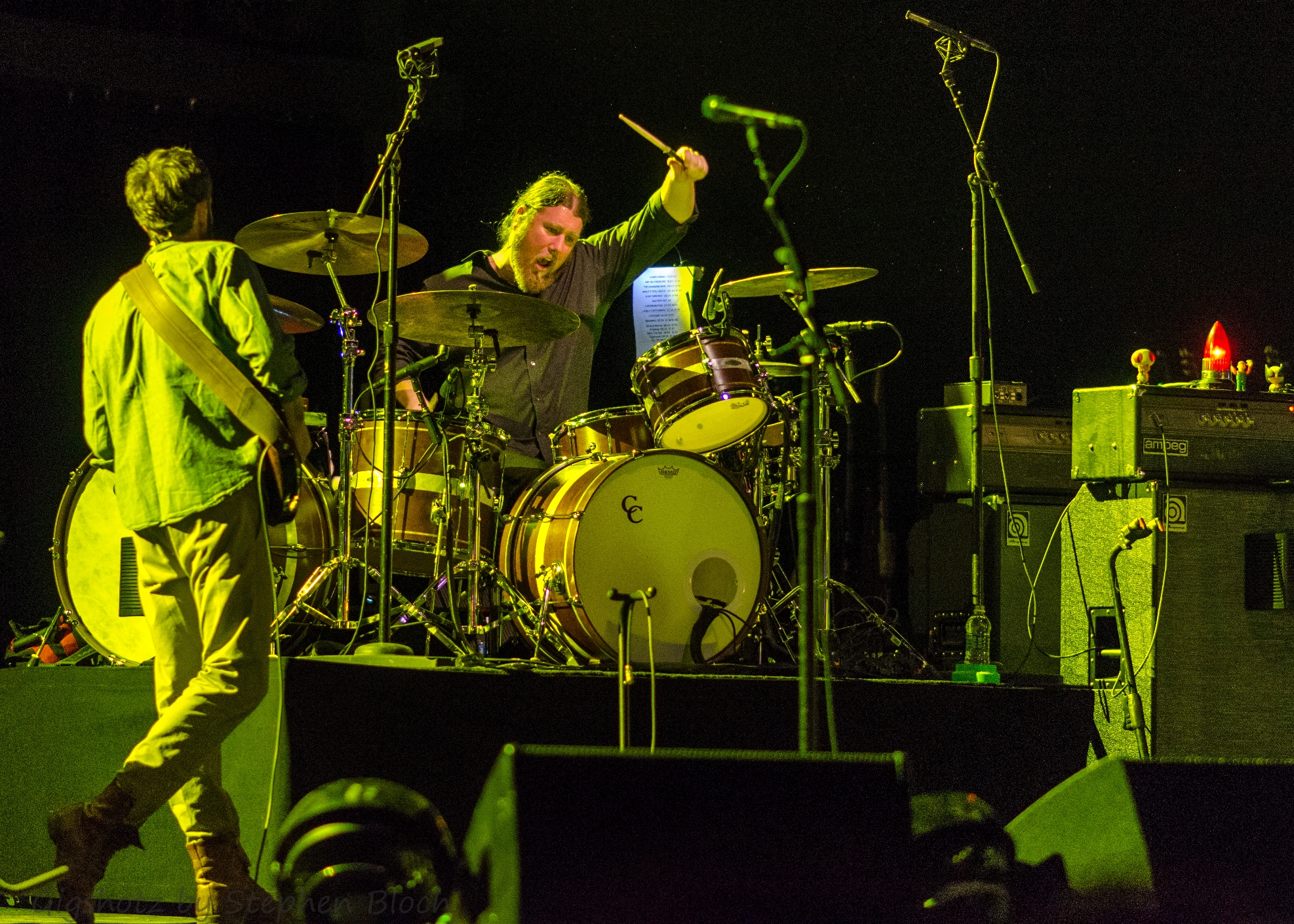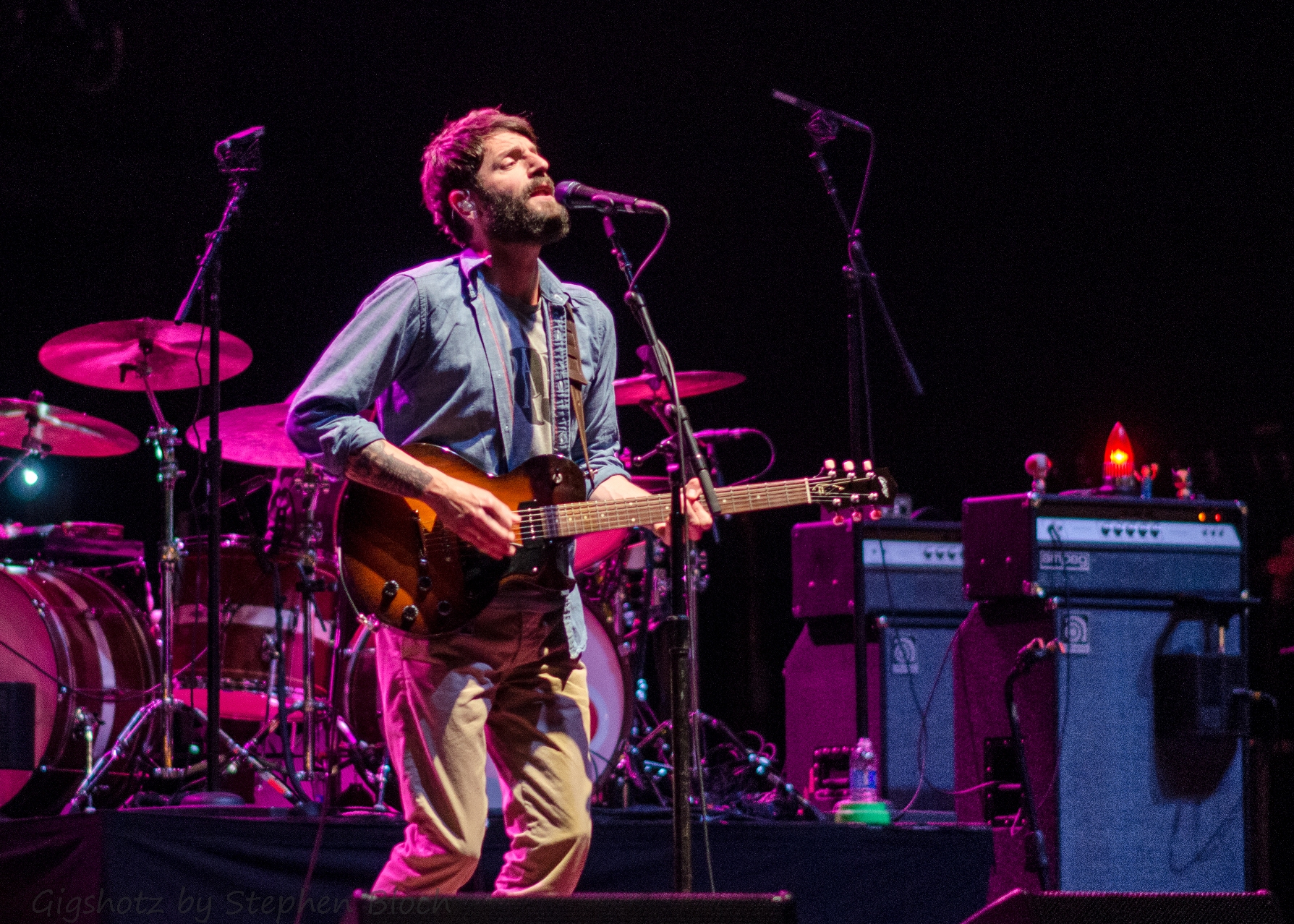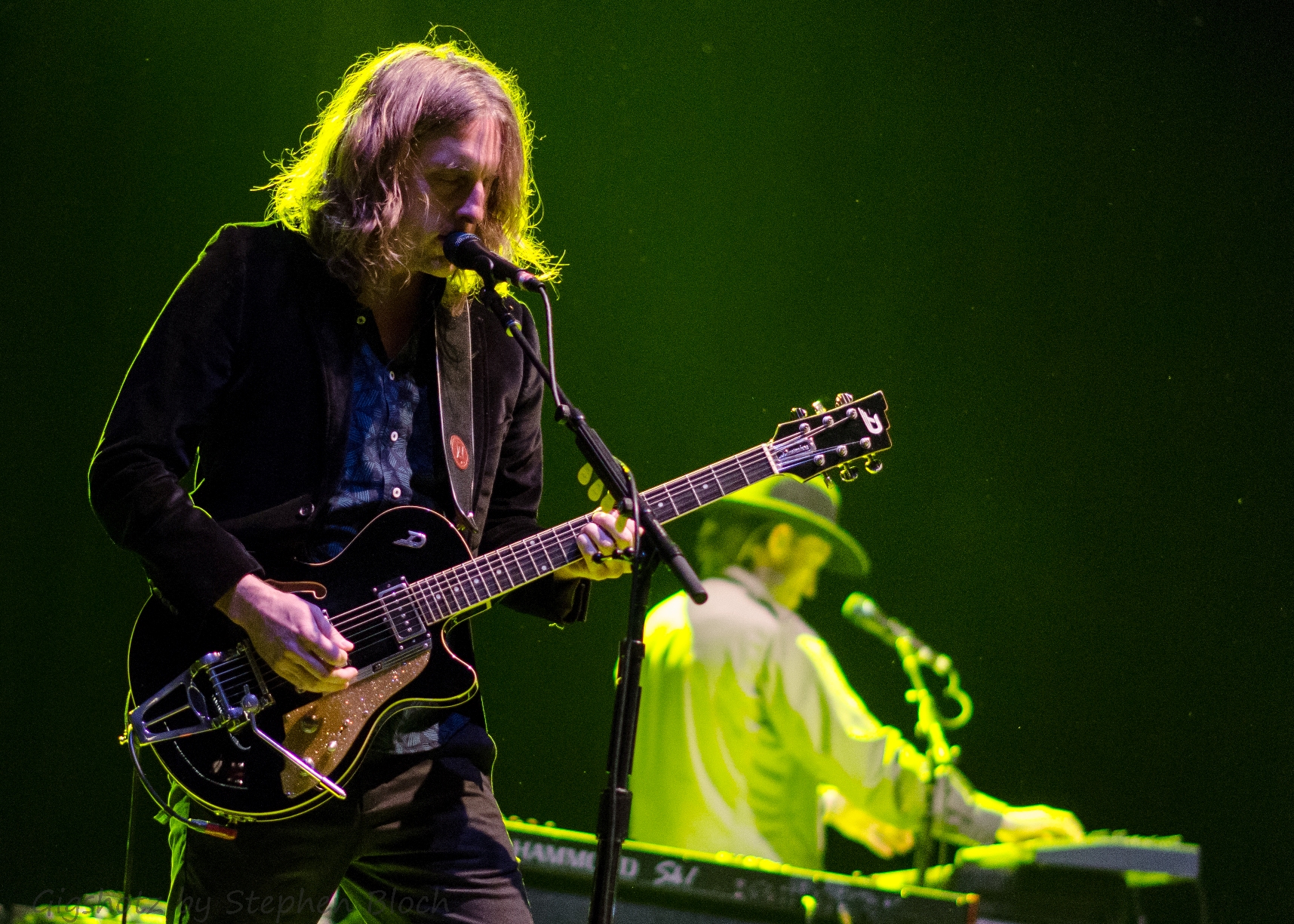Circular Progression: Ray LaMontagne and My Morning Jacket Deliver ‘Ouroboros’
 This excerpt originally appears in the July_August issue of Relix. To read the rest of this article as well as pieces on Ryan Adams, Eric Krasno, The Avett Brothers and much more, purchase the issue here. To subscribe, click here.
This excerpt originally appears in the July_August issue of Relix. To read the rest of this article as well as pieces on Ryan Adams, Eric Krasno, The Avett Brothers and much more, purchase the issue here. To subscribe, click here.
The sixth time was the charm for Ray LaMontagne. After recording five studio albums that fell short of his creative aims, he entered the studio with My Morning Jacket’s Jim James and crafted Ouroboros, the first recording that fully captures his artistic intent. The record consists of two rich, nuanced suites of music that unfold over nearly 20 minutes apiece and reveal themselves anew with each listen. This would be an estimable achievement in any time period, but it’s all the more so in an era of easily digestible iTunes singles.
But this is an era of easily digestible iTunes singles, and Ouroboros doesn’t fit that bill. It’s rewarding, entrancing and captivating—a creative expression that, for many listeners, is likely to endure as a resonant experience, which is just how Ray LaMontagne wanted it. The bean counters, however, not so much.
As much as the new album was a triumph—in fact, for the very reasons that the new album was a triumph—it became a source of consternation as well.
“Even after 12 years in the music business, I never really know where it’s coming from, who’s generating it—if it’s management, the label, the publishers,” LaMontagne says. “It comes to you, but it’s always veiled; you never really know who is the one. And I still don’t know. All I know is that someone, or a group of people, was extremely concerned. It was suggested to me that I re-record it from start to finish as an acoustic record so that people would understand it. That just pissed me off, really. I thought it was absurd. I don’t know where that came from exactly, but I think there was a lot of head-scratching going on and a lot of people not really knowing how they could make it work because there wasn’t a single of any kind.
“Jim and I said, ‘Just put it in the world. I’m going to tour; people will find it. It may take 30 years for it to become a part of people’s lives, but they’ll find it eventually.’ I equated it to hiking on a trail and you come upon those little stone cairns that people make. There’s no sign saying, ‘Stone cairn, made by Joe, 2014, up ahead.’ They just leave it there because it wants to be there and have people discover it.”
The path to discovery began in January 2005. At that time, LaMontagne, then 31 years old, had just released his debut LP, Trouble, to critical acclaim. Two weeks after his national TV debut on Late Night with Conan O’Brien, he traveled to Louisville, Ky., for an appearance at a 200-capacity venue known as the Rudyard Kipling. On hand to take in that performance were the members of My Morning Jacket, who had been rehearsing nearby.
“Before Trouble even came out, our publishing guys, who we’d been with a long time [Chrysalis Music Publishing], had found Ray and were getting ready to sign him,” Jim James recalls. “Jamie Cerreta, who’s one of my best friends and has been my publisher for a long time now, played me the demos that Ray was working on. I was in awe of his voice, which is just insane. I feel like his music is so organic and so natural— his voice above everything else. I could listen to him sing the dictionary.”
 My Morning Jacket bassist Tom Blankenship adds, “The first time we met Ray, I just felt, ‘Oh, right, you’re one of my people.’ We have the same kind of work ethic and come from a similar background. I think we’re all pretty introverted, quiet guys but have learned to express ourselves through music. I’ve always felt that if I didn’t have this opportunity, I don’t know how I would express a lot of the things that I need to.”
My Morning Jacket bassist Tom Blankenship adds, “The first time we met Ray, I just felt, ‘Oh, right, you’re one of my people.’ We have the same kind of work ethic and come from a similar background. I think we’re all pretty introverted, quiet guys but have learned to express ourselves through music. I’ve always felt that if I didn’t have this opportunity, I don’t know how I would express a lot of the things that I need to.”
LaMontagne echoes this sentiment: “I love music; I love the art form. I feel that I was born to write songs; I was born to make music. That’s my personal journey on this planet; that’s how I express myself.”
These kindred spirits circled over the years, discussing the possibility of touring or recording together, until, a decade after their initial meeting, LaMontagne and James finally made a commitment to collaborate in the studio.
“We blocked it out about eight or 10 months beforehand,” LaMontagne says. “I was on the road for the Supernova record, and I decided that we were just going to make it happen because it’s so difficult to get everyone’s schedules to line up. But we both made a concerted effort with that conversation—‘OK, this time we’re going to do it. It’s going to be the end of January, early February. We’re going to book it now and we’re going to stick to it. Whatever manager says, ‘Can you guys go to Australia? Can you go do this, or do that?’ We’re going to say, ‘No, this is happening; we’re going to do it.’’ That was key. I knew, in my mind, we both knew, that something was going to happen.”
Exactly what that something would turn out to be was altogether unanticipated. LaMontagne had produced his fourth album at home in Massachusetts. The soulful, country-inflected God Willin’ & The Creek Don’t Rise (2010) took home the Grammy for Best Contemporary Folk Album. Four years later, he enlisted The Black Keys’ Dan Auerbach to produce Supernova, his kaleidoscopic psych-rock follow-up, which proved to be a jolt to those people who expected him to release something in the roots-rock realm.
As LaMontagne describes it, he didn’t see that he had much of a choice, as he was simply doing what he had always done: following his muse. “I had to have faith in the creative process and whatever magical thing was happening there. I think of it as a Peter Pan-type character in my subconscious. He’s playful and he’s very mischievous—this is the side of my personality my friends see. But, like Peter Pan, he’s also a little bit touchy, so you have to let him do what he wants to do. You can’t tell him what to do, you can’t dictate, you can’t criticize. If Peter Pan comes to you and says, ‘Come play hide and seek,’ you play hide and seek. If you say, ‘I don’t want to do that. I want to play Parcheesi or I want to play checkers, I’m not in the mood for hide and seek,’ then Peter Pan will just disappear from your life and may never come back. Or you’ll be an old man by the time he does. It’s the same thing with creativity for me. To get the best out of myself, I have to let the mischievous, creative, playful side run with it, and just follow him and have faith in him.”
A similar consideration came into play when LaMontagne was crafting the material that would become Ouroboros. After he finished the Supernova tour in November 2014, LaMontagne took a few weeks to decompress and then began compiling a list of 15 songs that he identified as candidates for the new record. However, he hit a creative snag six weeks into the process, as he began working on demos of this material. “I just realized that they were resisting me,” he says. “Nothing in that batch was going to come together; it didn’t want to. At that point, I had maybe three and a half weeks to go before our session, and I thought, ‘OK, all of this stuff is going back in the drawer, and if you’ve got something to give me, if you know what you want to be, tell me.’ I just opened myself up to receive it. I didn’t know what the record wanted to be until maybe two weeks before we were supposed to start.
“It came to me at night while I was trying to sleep. I couldn’t turn my brain off because I had been thinking about music and songs for two months straight, all day. I was in that mode all the time, letting all this stuff in my subconscious stew all day and trying to grasp at these little melodic ideas and follow them. It was kind of intense, and there was a night when I was trying to sleep and it was sort of fitful and I couldn’t turn my brain off. I had this dream where I was sitting at my desk and all these different pieces of melodies that I had been thinking about for weeks were sort of floating above the table in all these different colors and just sort of settled onto my desk. I see colors when I think of the dream but, at the time, I was hearing things. It all sort of came together like a puzzle. I woke up with a horrible, splitting headache, but I could see that this piece leads into this piece, which leads into this melody, which could lead into this melody and now these four or five pieces totally make sense and these other three or four pieces put together make sense and, when you put them together, they make a circle. That was the moment where I realized that it wasn’t going to be a typical record with 10 songs and two singles; it was something else.”  What it was going to be was a paean to LaMontagne’s formative youthful experiences listening to vinyl. He recalls, “There are some records that after I would put them on, I would turn off the rest of the world and go on a journey. It’s how I listened to records, whether it was Blonde on Blonde or The Dark Side of the Moon. Those are some of my best memories—listening to records or getting my friends together, carving out that time and doing it. It’s really enjoyable—that whole experience of listening to the first side. Then, when you get to the end, everyone takes a breath and there’s a moment where you get another drink or you roll a joint and then everyone is like, ‘OK, are we ready? We’re going back in.’ It’s just a big communal experience.”
What it was going to be was a paean to LaMontagne’s formative youthful experiences listening to vinyl. He recalls, “There are some records that after I would put them on, I would turn off the rest of the world and go on a journey. It’s how I listened to records, whether it was Blonde on Blonde or The Dark Side of the Moon. Those are some of my best memories—listening to records or getting my friends together, carving out that time and doing it. It’s really enjoyable—that whole experience of listening to the first side. Then, when you get to the end, everyone takes a breath and there’s a moment where you get another drink or you roll a joint and then everyone is like, ‘OK, are we ready? We’re going back in.’ It’s just a big communal experience.”
Beyond that general experience, LaMontagne’s specific reference points for Ouroboros were two albums by the English new-wave band Talk Talk. Originally a synthpop group with early-‘80s singles such as “Today” and “Talk Talk,” the band charted a new course with their 1988 album, Spirit of Eden, an atmospheric record that moves across six soundscapes. The band’s 1991 follow-up, Laughing Stock, another seamless six-track collection, is a bit moodier and more intense than its predecessor.
Taking inspiration from all of these touchstones, LaMontagne emailed James to explain what he had in mind.
“I told him: ‘This isn’t going to be a record of songs, so I’m not sending you songs. I’m going to send you one song that has two parts.’ Then I said, ‘Have you heard Talk Talk’s Spirit of Eden or Laughing Stock? It’s like that but not so dark; there’s more of a release in there.’ I didn’t know that he had heard those records. I was thinking that I was going to turn him onto them and sort of point him in the right direction. But he immediately wrote back and said, ‘I just bought both those records on vinyl.’ They had re-released high-definition versions. From that point on, I had a really good feeling because we both knew where it was coming from.”
Ray LaMontagne believes in preparation. Before he enters the studio, LaMontagne assiduously shapes a collection of songs. His starting point becomes these well-developed home demos, along with a vision for the final track listing. It is through this purposeful, focused approach that he opens himself to outside contributors.
“The reason you bring a producer in,” he explains, “is because you want somebody to help you achieve what you’re hearing in your head. For me, it’s always textural things. I want to get these sounds and textures, or some other dimension that’s missing that I can’t quite put my finger on. That’s why I like to have someone in there that I can bounce ideas off of, and just say, ‘I’m really hearing this thing, this sort of pulsing thing that swirls and seethes and pulls you in, but I have no idea how to get that.’” In looking back at his first five records, he expresses frustration and dismay at his inability to achieve this intent. Ethan Johns produced LaMontagne’s initial three albums, Trouble (2004), Till the Sun Turns Black (2006) and Gossip in the Grain (2008). Since they worked together on multiple occasions, one might assume that they shared a positive working relationship, but LaMontagne demurs.
In looking back at his first five records, he expresses frustration and dismay at his inability to achieve this intent. Ethan Johns produced LaMontagne’s initial three albums, Trouble (2004), Till the Sun Turns Black (2006) and Gossip in the Grain (2008). Since they worked together on multiple occasions, one might assume that they shared a positive working relationship, but LaMontagne demurs.
“Ethan has a very generous heart but, in my opinion, he’s extremely childish and difficult to work with. My experience working with him was like butting heads with somebody for eight hours a day. But I’m a loyal friend, and we formed a friendship really early on, when I was just a pup, totally new to this world. It was a strange thing. I wasn’t quite sure— ‘How far do I let this guy go? How far do I let this guy push me in one direction or the other?’ I’d never stepped foot into a studio in my life. It was very difficult and a lot of decisions were made that I wasn’t happy with.
“I tried to take a much stronger role in helping to produce the second record, Till the Sun Turns Black. I remember bringing in Medeski Martin & Wood, who are stunning musicians, and we were working on some things, but we were shut down by Ethan. It was a very hard record to get through. Then the third record was a disaster, and that’s when I just decided that I couldn’t do it anymore. What good are you going to get in the studio if you are livid all the time because every decision turns into an argument? I am chill, and so for someone to push me to that point where it brings out the New England scrapper in me, that’s not fun.”
This led LaMontagne to produce his fourth album at home by himself, but he found this experience wanting as well. “I worked with wonderful people—it was a nice little batch of songs. But when I hear the God Willin’ record, I tell myself, ‘Ray, you need to have that other guy in the room with you. Someone you respect and who you can talk to, can help you get things you’re trying to get,’ because the God Willin’ record falls short of what I wanted.”
Then, after taking a few years away from the studio, during an era in which he re-assessed his own work and his approach to it, he turned to The Black Keys’ Dan Auerbach. LaMontagne had originally contacted him after hearing the Keys’ 2008 record Attack & Release to express his enthusiasm for the album, and that began an ongoing dialogue about some form of collaboration in the studio or live setting. The Supernova project started propitiously but did not end that way.  “We had great conversations on the phone,” LaMontagne reflects. “But, in the studio, I realized that there was a chemistry that was going to be difficult. You’ve got to roll with it, and I think we did really good work, but there was a point toward the end when it got to be more tense than it should be. Again, because of me saying, ‘No, that’s not where I want this to go,’ and Dan not taking that well. From that point onward, down to trying to get the track listing figured out, it was just butting heads when it just really didn’t need to be. At a certain point, it became counterproductive.”
“We had great conversations on the phone,” LaMontagne reflects. “But, in the studio, I realized that there was a chemistry that was going to be difficult. You’ve got to roll with it, and I think we did really good work, but there was a point toward the end when it got to be more tense than it should be. Again, because of me saying, ‘No, that’s not where I want this to go,’ and Dan not taking that well. From that point onward, down to trying to get the track listing figured out, it was just butting heads when it just really didn’t need to be. At a certain point, it became counterproductive.”
Given the nature of the material that would become Ouroboros, one could imagine some trepidation on LaMontagne’s part before he joined Jim James at his studio in Kentucky. However, LaMontagne professes that he went in open-eyed and optimistic, and affirms that he came out the other side with the most creatively satisfying studio experience of his life.
The My Morning Jacket frontman had both the proper temperament and tools for the gig. “One of the things that I really love about producing other people is that it’s not about me,” James indicates. “It’s about that other person and what he wants to see. I told Ray right off the bat: ‘Let’s have an honest dialogue. I’m going to tell you what I think should happen, and please tell me to fuck off if you think that’s not what you want to be happening, or tell me that you think that’s a great idea if you think it’s a great idea.’ There were certainly times when he told me, ‘Jim, I just don’t want to do that; you have to let it go.’ But, at the end of the day, he’s the one who’s got to live with this record. My name is on it, too, but he’s got to live and die by it, so the most important thing is that he’s happy. I feel like my number one job going into it was to make sure he walked out happy.”
This is precisely what transpired, as LaMontagne attests: “Jim was just great. It could be because we’re friends, but we hadn’t spent a week together like this, in a really creatively intense situation. It was just an open flow of suggestions and comments, and he was never, ever offended when I would say no. That’s beautiful because, ultimately, I needed to walk out of there saying, ‘I got it. I got just what I wanted to get, thank you.’ I didn’t want to walk out pissed off about certain things that will bug me for the rest of my life because instead of a conversation, it was an argument. So that was what Jim offered. He wanted to serve the music; he didn’t want to step all over it.”
To learn more about the creation of the album and the subsequent tour with My Morning Jacket, read the rest of this story, in the July_August issue of Relix or subscribe here.



















